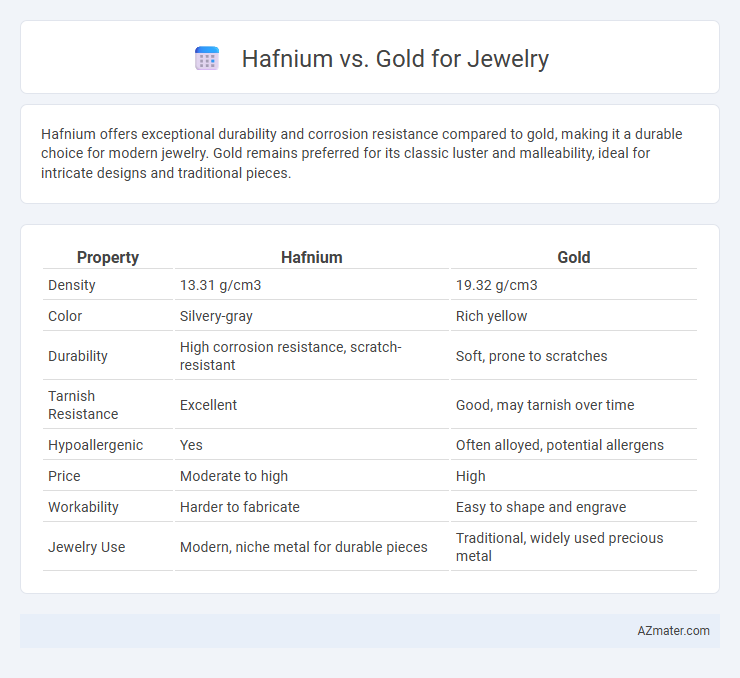Hafnium offers exceptional durability and corrosion resistance compared to gold, making it a durable choice for modern jewelry. Gold remains preferred for its classic luster and malleability, ideal for intricate designs and traditional pieces.
Table of Comparison
| Property | Hafnium | Gold |
|---|---|---|
| Density | 13.31 g/cm3 | 19.32 g/cm3 |
| Color | Silvery-gray | Rich yellow |
| Durability | High corrosion resistance, scratch-resistant | Soft, prone to scratches |
| Tarnish Resistance | Excellent | Good, may tarnish over time |
| Hypoallergenic | Yes | Often alloyed, potential allergens |
| Price | Moderate to high | High |
| Workability | Harder to fabricate | Easy to shape and engrave |
| Jewelry Use | Modern, niche metal for durable pieces | Traditional, widely used precious metal |
Introduction to Hafnium and Gold in Jewelry
Hafnium, a rare transition metal, is gaining attention in jewelry due to its exceptional resistance to corrosion and unique metallic luster, offering a modern alternative to traditional materials. Gold, long revered for its malleability, rich color, and enduring value, remains the benchmark for luxury jewelry with a history spanning thousands of years. Comparing their physical properties, gold's softness allows for intricate designs, while hafnium's durability and distinctive sheen cater to contemporary, innovative jewelry styles.
Physical Properties: Hafnium vs Gold
Hafnium exhibits a high melting point of approximately 2233degC and exceptional corrosion resistance, unlike gold, which melts at a significantly lower temperature of 1064degC and is renowned for its excellent malleability and ductility. Gold's density of 19.32 g/cm3 far exceeds hafnium's 13.31 g/cm3, making gold heavier and more valuable for traditional jewelry applications. While hafnium offers superior hardness and structural stability, its rarity and lack of natural luster limit its appeal compared to gold's iconic yellow hue and ease of fabrication.
Appearance and Aesthetics Comparison
Hafnium exhibits a unique, sleek metallic luster with a bluish-gray hue that stands out for modern, industrial-inspired jewelry designs, while gold offers a classic, warm yellow sheen renowned for its timeless elegance and versatility. The reflective quality of gold enhances intricate details and adds a rich depth to jewelry pieces, whereas hafnium's subtle shine provides a more understated, futuristic aesthetic. Gold's malleability allows for intricate patterns and settings, making it preferred for traditional luxury, whereas hafnium's rarity and distinct color appeal to avant-garde preferences.
Durability and Hardness in Jewelry Use
Hafnium exhibits exceptional durability and corrosion resistance, making it a promising material for jewelry that withstands everyday wear. Its hardness is notably higher than gold, with hafnium ranking close to titanium on the Mohs scale, providing enhanced scratch resistance compared to the softer, malleable nature of gold. Gold's traditional appeal lies in its luster and ductility, but hafnium's superior hardness and resilience contribute to longer-lasting, more robust jewelry pieces.
Hypoallergenic Qualities and Skin Safety
Hafnium offers superior hypoallergenic qualities compared to gold, making it an excellent choice for individuals with sensitive skin or metal allergies. Its corrosion resistance and inert nature minimize skin irritation and allergic reactions, whereas gold alloys, especially those mixed with nickel or other metals, commonly trigger sensitivities. Choosing hafnium jewelry ensures enhanced skin safety, reducing the risk of dermatitis and maintaining long-term comfort.
Cost and Market Value Differences
Hafnium is significantly less expensive than gold due to its rarity in commercial use and limited demand in jewelry, making its cost per gram much lower. Gold maintains a high market value driven by its historical status, widespread acceptance, and liquidity as a precious metal. The price disparity between hafnium and gold reflects their differing roles, with gold serving as both an investment asset and ornamental metal, while hafnium remains niche and largely industrial.
Availability and Workability for Jewelers
Hafnium is extremely rare and difficult to source, making it impractical for widespread use in jewelry compared to gold, which is abundant and globally traded. Gold's high malleability and ductility allow jewelers to craft intricate designs efficiently, while hafnium's hardness and brittleness limit its workability. The extensive refining infrastructure for gold ensures consistent quality, whereas hafnium's limited availability restricts its adoption in the jewelry industry.
Maintenance and Care Requirements
Hafnium jewelry requires minimal maintenance due to its exceptional corrosion resistance and hardness, making it highly scratch-resistant compared to gold. Gold, while softer and more prone to scratches, needs regular polishing and careful handling to maintain its luster and prevent tarnish, especially in higher karat varieties like 18K or 24K. Storage in a dry, non-abrasive environment is essential for both metals to preserve their appearance and longevity.
Popularity and Trends in Jewelry Design
Gold remains the most popular choice in jewelry design due to its timeless appeal, high cultural significance, and versatility in both classic and modern styles. Hafnium, though gaining interest for its unique metallic luster and rarity, is still an emerging material with limited market presence and niche appeal among avant-garde designers. Current trends show gold dominating luxury jewelry collections worldwide, while hafnium is often explored in experimental pieces seeking innovation and exclusivity.
Environmental and Ethical Considerations
Hafnium and gold differ significantly in environmental and ethical impacts for jewelry. Gold mining often leads to deforestation, water pollution, and unethical labor practices, whereas hafnium is typically sourced as a byproduct of zirconium extraction, which can reduce overall environmental disruption. Choosing hafnium can support more sustainable and ethical jewelry production by minimizing ecological damage and reliance on conflict-affected mining regions.

Infographic: Hafnium vs Gold for Jewelry
 azmater.com
azmater.com